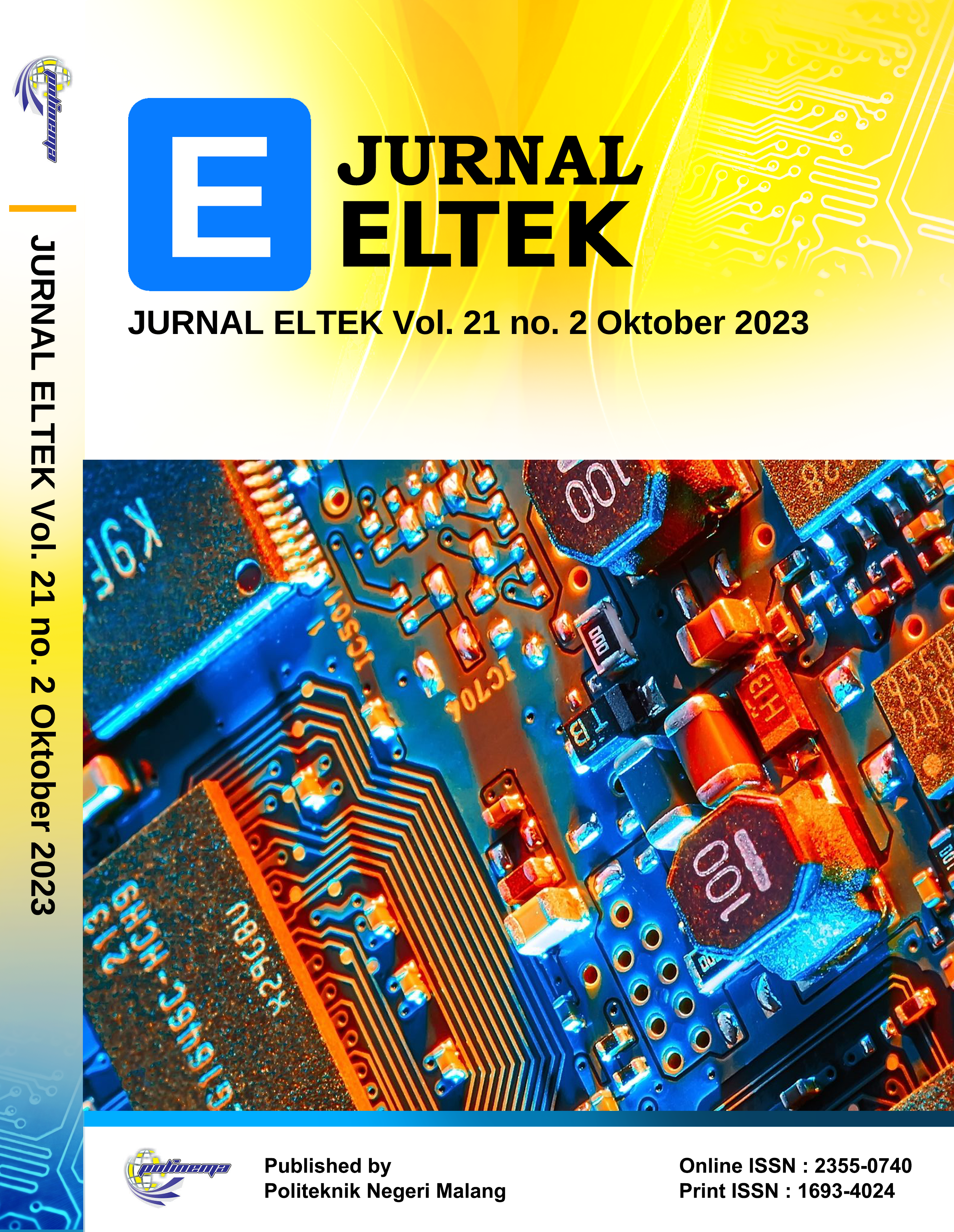Implementasi sistem kontrol penggerak motor stepper pada proses molding microplastic berbasis PID menggunakan PLC
DOI:
https://doi.org/10.33795/eltek.v21i2.2024Keywords:
Motor Stepper, PID, Injection MoldingAbstract
Industri saat ini telah memasuki era yang setiap proses produksinya telah menerapkan otomatisasi dan pertukaran data dalam manufakturnya yang dikenal sebagai era industri 4.0. Era Industri 4.0 juga memberikan dampak pada industri percetakan barang seperti percetakan barang dari bahan plastik yang penerapannya menggunakan teknik injection molding. Teknik ini mampu menghasilkan produk yang lebih presisi. Dalam proses injection molding perlu sistem kontrol yang baik agar mampu mengarahkan biji plastik dalam proses mold sesuai yang direncakan. Tentunya dibutuhkan aktuator yang meliputi penggerak yang dalam hal ini bisa berupa motor stepper. Penelitian ini bermaksud ingin mengaplikasikan metode PID dalam mengontrol motor stepper pada proses molding microplastic. Sistem yang diusulkan telah berhasil dibuat dan mampu menghasilkan produk sesuai dengan perencanaan. Hasil kontrol pada motor stepper yang paling tepat pada nilai parameter PID yakni nilai Kp = 14, nilai Ki = 0.007 dan nilai Kd = 7000. Perubahan nilai setpoint dari 2500 hingga 2700 memberikan pengaruh terhadap hasil cetakan dan nilai setpoint yang menghasilkan cetakan yang paling bagus pada nilai setpoint sebesar 2700. Nilai setpoint sebesar 2700 menghasilkan kondisi mold dan nozell dalam posisi yang tepat atau rapat, hal ini membuat proses cetakan berjalan dengan baik sesuai dengan desain dari cetakan yang diberikan.
ABSTRACT
The current industry has entered an era where every production process incorporates automation and data exchange in its manufacturing. This era is known as Industry 4.0. Industry 4.0 has had a significant impact on various industrial sectors, particularly in the production of plastic goods using techniques such as injection molding. This process is capable of producing more precise products. In the injection molding process, a well-controlled system is needed to guide plastic pellets according to the intended mold design, utilizing actuators like stepper motors. This research aims to apply the PID (Proportional-Integral-Derivative) method to control stepper motors in microplastic molding processes. The proposed system has been successfully implemented and can produce products according to the planned specifications. The most suitable PID parameter values for controlling the stepper motor are Kp = 14, Ki = 0.007, and Kd = 7000. Changing the setpoint value from 2500 to 2700 has an impact on the molding results, with the best results achieved at a setpoint value of 2700. A setpoint value of 2700 ensures that the mold and nozzle are in the correct, tight position, allowing the molding process to proceed smoothly in line with the provided design.
References
N. Purba, M. Yahya, and Nurbaiti, “Revolusi Industri 4.0 : Peran Teknologi Dalam Eksistensi Penguasaan Bisnis Dan Implementasinya,” J. Perilaku Dan Strateg. Bisnis, vol. 9, no. 2, pp. 91–98, 2021.
I. Yulianto, Rispianda, and H. Prassetiyo, “Rancangan Desain Mold Produk Knob Regulator Kompor Gas pada Proses Injection Molding,” Reka Integr. J. Online Institu Teknol. Nas., vol. 2, no. 3, pp. 140–151, 2014.
S. Zhang, R. Dubay, and M. Charest, “A principal component analysis model-based predictive controller for controlling part warpage in plastic injection molding,” Expert Syst. Appl., vol. 42, no. 6, pp. 2919–2927, 2015.
W. L. Chen, C. Y. Huang, and C. Y. Huang, “Finding efficient frontier of process parameters for plastic injection molding,” J. Ind. Eng. Int., vol. 9, no. 1, 2013.
E. Müller, R. Schillig, T. Stock, and M. Schmeiler, “Improvement of injection moulding processes by using dual energy signatures,” Procedia CIRP, vol. 17, no. Imm, pp. 704–709, 2014.
Y. qi Wang, J. gyu Kim, and J. il Song, “Optimization of plastic injection molding process parameters for manufacturing a brake booster valve body,” Mater. Des., vol. 56, pp. 313–317, 2014.
A. Sudamanto, Sumariyah, and I. Gunadi, “Rancang Bangun Pengendali Motor Stepper Untuk Deteksi Jumlah Obyek Putar dengan menggunakan Komputer,” Berk. Fis., vol. 14, no. 1, pp. 17–22, 2015.
M. Alwi, T. Tohir, and N. Mulyono, “Sistem Kendali Pemilihan Kecepatan pada Motor Stepper Menggunakan Metode Fuzzy Mamdani Berbasis PLC,” IRWNS Ind. Res. Work. Natl. Semin., pp. 63–68, 2023.
R. Rahmat and W. Wiyono, “Rancangbangun Perangkat Kendali Motor Stepper Dengan Mikrokontroler,” Jural Tek., vol. 7, no. 3, pp. 99–107, 2022.
B. C. Wibowo and F. Nugraha, “Kendali Kecepatan Motor Stepper Menggunakan Metode Start – Stop Berbasis PLC,” J. Tek. Elektro dan Komput., vol. 10, no. 3, p. 213, 2021.
H. Supriyanto, F. Suryatini, A. R. H. Martawireja, and H. Rudiansyah, “Implementasi Kontroler Pid Dengan Metode Tuning Ziegler-Nichols Dan Cohen-Coon Pada Sistem Scada Kendali Level Air,” JTT (Jurnal Teknol. Ter., vol. 8, no. 2, p. 149, 2022.
H. A. Pramoedya, B. Priyadi, and M. Luqman, “Implementasi Kontrol PID Untuk Mengontrol Suhu dan Level Pada Alat Vending machine,” J. Elektron. dan Otomasi Ind., vol. 10, no. 1, pp. 18–25, 2023.
S. F. Anggraini, A. Ma’arif, and R. D. Puriyanto, “Pengendali PID pada Motor DC dan Tuning Menggunakan Metode Differential Evolution,” TELKA - Telekomun. Elektron. Komputasi dan Kontrol, vol. 6, no. 2, pp. 147–159, 2020.
R. Rizeki, B. Setiyono, and M. A. Riyadi, “Perancangan Sistem Kontrol Motor Berbasis Kontrol PID Dengan Menggunakan Mikrokontroller ATmega8535 Pada Sizing Process Sistem Weaving I Greige Di PT . Apac Inti Corpora,” Skripsi Fak. Tek. Univ. Diponegoro, vol. 4, no. 3, pp. 771–779, 2015.
N. Z.A, Y. P. Roja, and N. Sylvia, “Aplikasi Kontrol PID pada Reaktor Pabrik Asam Formiat dengan Kapasitas 100.000 Ton/Tahun,” J. Teknol. Kim. Unimal, vol. 7, no. 2, p. 135, 2019.
Downloads
Published
How to Cite
Issue
Section
License
Copyright (c) 2023 Alvian Anggiana Putra Anggiana, Muhammad Rifa'i, Hari Kurnia Safitri

This work is licensed under a Creative Commons Attribution-ShareAlike 4.0 International License.







